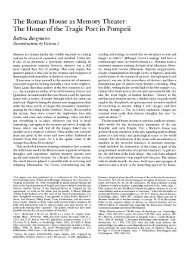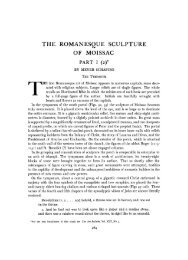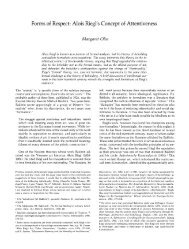THE HUMANISTIC THEORY OF PAINTING - College Art Association
THE HUMANISTIC THEORY OF PAINTING - College Art Association
THE HUMANISTIC THEORY OF PAINTING - College Art Association
Create successful ePaper yourself
Turn your PDF publications into a flip-book with our unique Google optimized e-Paper software.
UT PICTURA POESIS: <strong>HUMANISTIC</strong> <strong>THE</strong>ORY <strong>OF</strong> <strong>PAINTING</strong> 243<br />
We shall now consider briefly some aspects of the pictorial treatment of this episode.217<br />
And it should be very clearly stated at the beginning that the painters who illustrated<br />
Tasso's story were not the conscientious scholars that the critics for the sake of decorum or<br />
verisimilitude would have them be. For they not only took liberties with the text when<br />
pictorial exigency required it, as they were generally forbidden to do by the critics, but<br />
also employed traditional forms of composition or iconography that had served the painters<br />
and sculptors of antiquity or their own Renaissance predecessors for illustration of fables<br />
that, more often than not, bore some similarity to various episodes in Tasso's poem. Here<br />
was the use of another kind of knowledge that the critics, even while urging a thorough<br />
knowledge of the antique, and of the best art of the moderns, with their strong literary<br />
predilections scarcely took into account: a knowledge that the painter does not acquire<br />
from books, but from association with the traditional language of the arts of representation<br />
that his genius is forever evoking into new possibilities of composition and of interpretation.<br />
The first scene in the episode, as it appears in Poussin's version in Leningrad, represents<br />
Armida falling in love with Rinaldo as he lies asleep on the bank of the river Orontes (Fig.<br />
I). As she bends over to kill the Christian warrior who is her mortal enemy, her hate is<br />
suddenly transformed into love.218 Now Poussin, who was in conscious sympathy with the<br />
humanistic doctrine ut pictura poesis, could be expected in his pictorial rendering of such an<br />
episode to be reasonably faithful to the spirit of his text, and he has even been careful, in<br />
addition to rendering Rinaldo in armor which would distinguish him from an Adonis or<br />
Endymion in a similar grouping,219 to display at the right, as unmistakable means of<br />
identifying the subject, the column that bore the legend enjoining Rinaldo to discover the<br />
hidden marvels of the island in the midst of the river.220 Poussin might indeed have pleased<br />
some of the critics by including as other painters did the nymphs whose song enchanted<br />
Rinaldo into slumber;221 but these from considerations of formal composition and dramatic<br />
effectiveness he evidently rejected as superfluous to his composition. He might have satis-<br />
fied an extreme purist among the critics by indicating that he had studied the geography<br />
and dress of Syria after the manner of the nineteenth-century romantic painters. But this<br />
would have been to call attention to adventitious and local detail at the expense of universal<br />
truth. Poussin's naturally abstemious genius, fortified by the teaching of antiquity, neces-<br />
sarily rejected any such conformity with pedantic theorizing; and for the student of ut<br />
pictura poesis, the influence of antiquity on this painting is particularly illuminating.<br />
The picture dates between 1635 and 1640222 and may be the earliest example of a scene<br />
never popular among Italian painters. It shows Poussin using various features of the<br />
story of Endymion which he could have seen represented on several antique sarcophagi in<br />
Rome during the years of his life there. A drawing by Poussin in Chantilly of a sarcophagus<br />
217. I am engaged at present in preparing a book on the<br />
influence of this poem and of Ariosto's Orlando Furioso on<br />
the history of painting, in which the illustration of this<br />
episode will be treated with greater completeness.<br />
218. Canto xIv, stanzas 65-67:<br />
"Esce d'agguato allor la falsa maga,<br />
E gli va sopra, di vendetta vaga.<br />
Ma quando in lui fiss6 lo sguardo, e vide<br />
Come placido in vista egli respira,<br />
E ne'begli occhi un dolce atto che ride,<br />
Ben che sian chiusi (or che fia s'ei li gira?)<br />
Pria s'arresta sospesa, e gli s'asside<br />
Poscia vicina, e placar sente ogn'ira<br />
Mentre il risguarda; e in su la vaga fronte<br />
Pende omai si, che par Narciso al fonte.<br />
E quei ch'ivi sorgean vivi sudori<br />
Accoglie lievemente in un suo velo;<br />
E, con un dolce ventilar, gli ardori<br />
Gli va temprando de l'estivo cielo<br />
Cost (chi'l crederia?) sopiti ardori<br />
D'occhi nascosi<br />
quel gelo<br />
Che s'indurava al distempr.r cor piid che diamante;<br />
E, di nemica, ella divenne amante."<br />
219. As in Poussin's own Death of Adonis in the Museum<br />
of Caen. See O. Grautoff, Nicolas Poussin, Munich, 1914,<br />
II, p1. 34.<br />
220. Canto xiv, stanzas 57-58.<br />
221. Simon Vouet painted such a version (see note 228).<br />
222. See Friedlaender, op. cit., p. 51.










